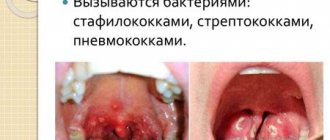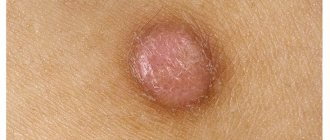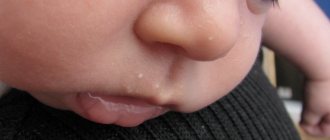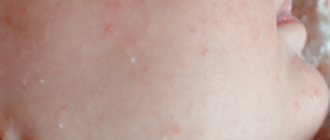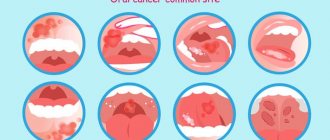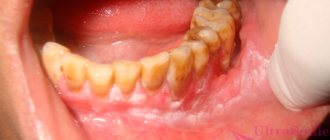The presence of white lumps in the throat with an unpleasant odor is a characteristic symptom of inflammation of the tonsils
of a viral or bacterial nature. Most often, this symptom indicates chronic tonsillitis (tonsillitis). Usually a person does not even suspect the presence of pus balls in the throat until they begin to “come out” along with sputum when coughing or sneezing.
Whitish lumps in the tonsils with tonsillitis
Exacerbation of chronic or the onset of acute tonsillitis can be recognized by the following signs:
- bad breath, a sour taste in the mouth;
- there is an increase in body temperature;
- periodically painful sensations occur during eating and swallowing;
- pain appears in the throat, head, and cervical region.
Why do purulent plugs form and what do they consist of?
Photo: this is what white lumps on the tonsils look like
Many people believe that the white things in the throat and tonsils are just small pieces of food that have begun to rot and give off a rotten smell. Residues of food are indeed present in these formations, but basically calcified miniature balls consist of dead bacteria that entered the body along with air, and leukocytes, aimed at fighting them by the human immune system.
Microorganisms that cause inflammation in the tonsils produce hydrogen sulfide. They need this substance to protect against oxidative processes and subsequent destruction of DNA; it also emits the aroma of rotten eggs, due to which the patient’s mouth begins to smell bad.
The “culprits” for the formation of yellow and white lumps on the tonsils
There are several types of microorganisms that cause a whitish coating to form on the tonsils, which gradually turns into miniature pebbles. It can be:
- Streptococci. A bacterial infection causes symptoms such as frequent vomiting, fever, abdominal pain, swollen lymph nodes, and a rash.
- Epstein-Barr virus, which causes infectious mononucleosis, can also cause white, hard lumps in the mouth that have a foul odor. The presence of the disease is indicated by the following signs: high body temperature, enlarged tonsils and pain in the larynx. In advanced cases, clots of pus may be released.
- Herpes Simplex Virus (HSV-1), leading to the development of oral herpes. Most often, the disease can be recognized by the presence of sores on the lips. Simultaneously with the appearance of bubbles on the outer surface of the lip, a whitish or yellowish coating may form on the mucous membranes of the tonsils, which later transforms into stones.
Children's and adult ENT doctor, audiologist, otoneurologist, candidate of medical sciences, Budanov E.G.
Inflammatory diseases of the throat are one of the most common conditions that pediatric and adult ENT doctors encounter in their medical practice. The most commonly observed viral infections lead to pharyngitis or tonsillopharyngitis, which requires predominantly local and symptomatic treatment. However, in the age group of children over 4 years old, bacterial causes of acute, recurrent or chronic inflammation of both the throat itself and its tonsils will increasingly be observed. Bacterial infections of this localization are especially characteristic in primary and secondary school age up to 15 years. Many patients, having matured and graduated from school, stop complaining of regular inflammatory diseases of the throat, but in some adults such complaints persist. Among such patients, there are often those who are worried mainly by one main complaint - the frequent formation of the so-called. “plugs” on the palatine tonsils. From the stories of the patients, it follows that they had previously suffered from sore throats or severe pharyngitis with varying frequencies, or, on the contrary, did not have any distinct inflammatory diseases of the throat. At some point in time, they begin to experience sensations of a foreign body in the throat, possible discomfort, bad breath; upon self-examination of the throat, the formation of plaque, “lumps” or “plugs” on the palatine tonsils is noted. As a rule, patients try to remove them on their own: they intensively gargle, squeeze out these “plugs” from the tonsils using cotton swabs, a spatula, a regular spoon, etc. Despite these efforts, plugs in the tonsils form again and again. Some patients experience periodic or constant pain or a sensation of a lump in the throat, soreness and enlarged lymph nodes in the neck. Someone notices an increase in the number of plugs on the tonsils after colds, eating sweet or dairy foods. Often repeated or unsuccessful attempts to get rid of traffic jams lead the patient to an appointment with an ENT doctor or therapist. In this case, the task of the medical worker is to inform the patient about the reasons for his complaints, clarify all the accompanying circumstances and develop correct and effective treatment tactics to eliminate blockages on the palatine tonsils and prevent their occurrence. First of all, it is necessary to explain to the patient that tonsil plugs are not an independent disease, but one of the manifestations of deeper structural and functional changes that occur in the palatine tonsils due to the development of chronic infectious inflammation in them. The formation of plugs on the tonsils is based on the peculiarity of their structure, which consists in a well-developed system of depressions (niches or lacunae) on their surface, penetrating deeply into the tonsils. On the one hand, this provides a large contact surface for the effective functioning of the local immune system of the tonsils. On the other hand, with the development of long-term inflammation, which ultimately leads to cicatricial structural rearrangement of tissue, the lacunae become deformed and their lumen narrows. This leads to disruption of drainage and self-cleaning of lacunae during chewing and swallowing; food fragments actually remain in the lumen of the lacunae for a long time for days and weeks, becoming a breeding ground for bacteria. This leads to another predisposing factor - the presence of pathogenic microorganisms on the surface and in the lumen of the lacunae of the palatine tonsils, which settle on food fragments, forming a dense conglomerate around them, where the protective cells of the local immune system - leukocytes - rush. Gradually, a small conglomerate of “food-bacteria-leukocytes” increases, becomes denser, fills the entire lumen of the palatine tonsil lacuna and begins to protrude from its lumen on the surface visible to us when examining the throat. A large accumulation of bacteria and leukocytes causes an inflammatory reaction, which is manifested by a feeling of local discomfort, soreness, a feeling of a foreign body; it is also possible to develop a general inflammatory reaction with malaise, increased fatigue, and a slight persistent increase in body temperature. Understanding the mechanism and predisposing causes for the development of plugs on the palatine tonsils allows us to propose the correct treatment tactics. First of all, you should find out all the circumstances of the development of a persistent infection in the throat: perform a smear on microflora and sensitivity in order to select local and general antibacterial and antiseptic treatment, as well as to develop measures to prevent recurrence of the infection. It is necessary to establish all concomitant and predisposing factors that promote or aggravate local inflammatory processes in the throat: the state of immunity, the presence of concomitant autoimmune diseases or complications, the functional state of the heart, kidneys, blood vessels, joints, as target organs for complicated chronic infections in the throat, etc. d. The ENT doctor should evaluate the functional state of the palatine tonsils themselves in order to decide on the possibility of more gentle organ-saving treatment. Otherwise, if there are serious preconditions or consequences of a chronic infection in the throat, the question of removing the tonsils (tonsillectomy) is raised, when the very issue of treating “tonsil plugs” will be exhausted. In the case of possible preservation of the palatine tonsils and refusal of tonsillectomy, it is necessary to develop tactics of effective local and general treatment to achieve a lasting effect.
Treatment should include several points:
- It is necessary to eliminate the chronic bacterial infection, which underlies the inflammation and structural changes of the tonsils. For this purpose, information obtained from the results of a microbiological examination (smear) is used. Based on the obtained sensitivity to antibacterial drugs, effective local antibiotics and/or antiseptics are selected, which are used in the form of irrigation (gargling), in the form of sprays or as solutions for washing the lacunae of the tonsils, carried out by an ENT doctor. As a rule, these are solutions of chlorhexidine, miramistin, dioxidine, mestamidine, or plant origin - chlorophyllipt. The data obtained is also used for prevention. The patient may be recommended to apply local applications to the palatine tonsils of solutions or gels containing bacteriophages, including using the ultrasound method using the Tonzillor or similar apparatus.
- All of the approaches described above have their own therapeutic effect, but in most patients it is temporary and in the future there is a tendency to relapse in the formation of new plugs on the tonsils, since structural changes in the surface of the tonsils persist. This contributes to the re-accumulation of small fragments of food in the deformed and tortuous lumens of the lacunae with the repeated formation of conglomerates of bacteria and leukocytes around them. Therefore, at present, these methods should be considered as a preparatory stage for more effective treatment that gives a much more lasting effect, aimed at complete obliteration (closing) of the lumen of the tonsil lacunae. This procedure is called “lacunotomy” or “cryptolysis”, with its help it is possible to eliminate the mechanism of the emergence and accumulation of new plugs by targeted destruction of the input channels of the lacunae of the tonsils, ending with their sclerosis. For this purpose, a surgical instrument based on a laser or radio wave radiation is used, which makes it possible to provide an almost precise, stable dosed effect on the surface of the tonsil in the area of the lacunae. Subsequently, scar tissue forms in this place, which actually blocks the lumen for bacteria and food fragments to penetrate deep into the tonsils. Currently, lacunotomy is considered as an effective alternative to organ-preserving minimally invasive intervention to repeated washing of the tonsils or their removal.
- A competent, effective approach to local treatment of tonsil plugs can significantly improve the quality of life of patients with this condition. However, one should also take into account the general condition of the body, which is under a toxic and inflammatory load from chronic inflammation in the throat. It is necessary to take into account the state of immunity, establish the risks of developing autoimmune complications and rheumatic consequences of chronic tonsillitis, which underlies the formation of caseous plugs on the tonsils. Based on the total examination of the patient and his examination, consultation with an infectious disease specialist, rheumatologist, dentist, immunologist or other specialists, the appointment of anti-rheumatic prophylaxis and other therapeutic and preventive measures may be necessary. Limited treatment of local complaints alone cannot guarantee a lasting improvement in health status and the prevention of complications of chronic inflammatory diseases of the lymphoid formations of the upper respiratory tract.
Other causes of stones in the tonsils
In most cases, the cause of the formation of whitish plugs on the tonsils that have an unpleasant odor is chronic tonsillitis.
But she is not the only one possible. White lumps on the tonsils can be found with the following diseases:
- Chronic sinusitis. With this disease, thick whitish or yellow mucus is produced, which accumulates in the larynx area. Clots of mucus become the culprits of the unpleasant odor from the mouth and lead to a strong cough with sputum, which may contain miniature whitish balls.
- Peritonsillar abscess that occurs against the background of advanced acute or chronic tonsillitis. The disease is characterized by the accumulation of pus in one of the tonsils. This pathological condition is accompanied by a sore throat, high body temperature and painful sensations in the neck.
- Oral candidiasis is another reason for the appearance of white balls in the throat. The disease, caused by the activation of fungi of the Candida albicans group, leads to the appearance of whitish deposits in any part of the oral cavity: on the tongue, inside the cheeks, gums, palate, tonsils.
The appearance of painless tumors in the tonsil area may indicate salivary gland cancer. Therefore, if any tumors or formations appear in this part of the oral cavity, you should consult a doctor as soon as possible.
Causes of traffic jams, tonsillitis
It is important to determine not only how to remove plugs from the tonsils, but also to understand the cause of their appearance. The main factor is the constant presence of a focus of inflammation. A person always has bacteria in the oral cavity, on the surface of the mucous membranes of the pharynx and tonsils. They are successfully dealt with by immune cells of lymphoid tissue.
Healthy tonsils are capable of self-cleaning - dead cells are removed from the lacunae and enter the stomach, where they are destroyed by gastric juice. But when viruses enter, a larger number of immune cells - leukocytes - are required. The mucous membrane of the palatine tonsils becomes swollen, the tissues become loose, and the lacunae become difficult to clean. Dead mucous cells, dead bacteria and leukocytes accumulate in the tonsils - this is what plugs are made of.
Active and passive drainage of tonsil lacunae allows one to develop immunity to many microorganisms. But even a single case of acute inflammation and its subsequent transformation into chronic inflammation can disrupt this process. Doctor Ovchinnikov Yu. M. emphasizes that “discharge in the lacunae can be purulent, caseous, accumulate in narrow lacunae convoluted with spurs, and form so-called fetid plugs” (Ovchinnikov Yu. M., 2000, 538)
Are whitish lumps dangerous and why?
Whitish dots or lumps on the mucous membranes of the throat and tonsils indicate the presence of an inflammatory process. If you ignore such a serious problem, there is a high probability of intoxication of the entire body.
In the process of fighting the causative agent of the disease (virus, bacteria), the body’s immune-protective functions will weaken, which can lead to undesirable consequences:
- the occurrence of pain in muscles and joints, which sometimes develop into more serious conditions (rheumatism);
- disturbances in the functioning of the cardiovascular system (arrhythmias and tachycardia);
- kidney damage;
- Allergic reactions may occur.
Hard lumps on the tonsils are formed due to an inflammatory process, the causative agent of which can spread throughout the body. Therefore, if formations are detected in the expectant mother, she should immediately contact a specialist - the disease can pose a serious danger to the fetus.
Prevention of the formation of purulent plugs
Purulent plugs are almost always the result of a sluggish inflammatory disease - chronic tonsillitis. Therefore, the main measure to prevent their formation is attention to your health and timely treatment of the underlying disease. It is important to influence all stages of the development of the disease. Prevention consists of following the following doctor’s recommendations:
- Personal hygiene: mandatory brushing of teeth twice a day, timely sanitation of the oral cavity, if possible, rinsing the mouth after eating, especially sweets.
- Timely and complete treatment of tonsillitis according to the doctor’s recommendations: properly selected antibacterial therapy will help prevent chronic inflammation. Regular and frequent gargling will help clear the tonsils, reducing the likelihood of plugs forming in the loose tissues.
- Drinking regimen: drinking plenty of fluids during exacerbations helps cleanse the palatine tonsils of contents and promote rapid recovery.
- Timely treatment of concomitant pathologies, rehabilitation of foci of infection: treatment of caries and inflammation of the gums, correction of the nasal septum when it is bent, treatment of sinusitis, etc.
- Preventing hypothermia. It helps to reduce defenses and activate opportunistic microorganisms in the tonsils.
Sometimes the only option to remove tonsil plugs is to remove them, so it is important to consult a specialist to make the right decision.
Be sure to contact a specialist regarding the removal of purulent plugs from the tonsils in adults for professional, qualified help. The information contained in this material is not a call for self-medication; it is presented for informational and informational purposes. The authors adhere to a scientific point of view and are not responsible for the quality of services provided by third parties.
How to treat white lumps in the throat
A small number of white dots on the tonsils indicates chronic tonsillitis. In order to avoid the occurrence of putrid odor from the mouth and the “growth” of plaques, it is necessary to undergo a set of procedures prescribed by an ENT doctor twice a year. Paying attention to your health will help you avoid serious complications.
The method of relieving the disease entirely depends on the cause of the appearance of white balls on the tonsils. For example, if we are talking about infection of the tonsils with bacteria, then the disease cannot be cured without taking antibiotics.
To determine which antibacterial medicine will be the most effective, it is necessary to undergo an analysis of the resistance of the pathogen to different groups of agents. That is why you cannot independently choose a drug for treatment, as well as determine the dosage. This should be done exclusively by an ENT doctor.
Drug therapy
Depending on the results of laboratory tests, the patient is prescribed one of the following drugs:
- Clarithromycin.
- Amoxicillin.
- Cefoperazone.
- Augmentin.
To treat an advanced disease, several drugs that have an antibacterial effect may be prescribed at once.
To effectively get rid of white lumps that appear on the tonsils due to chronic tonsillitis, it is necessary to combine antibiotics with the following drugs:
- Products with a disinfecting effect. The most popular are Chlorhexidine and Dioxidine. You can also rinse your mouth with herbal infusions (sage, chamomile).
- During the period of exacerbation of the chronic form of the disease, the doctor prescribes anti-inflammatory drugs: Panadol, Nurofen. Sometimes doctors advise taking homeopathic remedies. The most popular - Tonsilton - has no side effects and is recommended for the treatment of tonsillitis in children.
- Taking vitamin complexes. The inflammatory process affects the entire body, but the immune system is particularly damaged. To get rid of dizziness, poor health and improve the functioning of the immune system, you need to diversify your diet and take vitamins, the composition of which is replete with basic micro and macroelements, useful substances necessary for the normal functioning of all organs and systems.
Physiotherapeutic treatments
In addition to taking medications and gargling, it is recommended to undergo a course of physiotherapeutic procedures. Their type and duration are determined by the attending ENT doctor. The following types of physiotherapy are distinguished:
- ultrasonic;
- microwave therapy;
- UHF;
- laser irradiation.
Local therapy
Washing the tonsils
Quite often, experts prescribe medications for resorption (Septolete or Hexalize) and recommend taking a course of procedures for washing the lacunae of the tonsils. This manipulation is extremely difficult to do at home without experience, so it is better to take a course from a doctor.
Traditionally, the otolaryngologist prescribes 10–15 procedures; for rinsing, the specialist uses a copper-silver solution, which has a disinfecting effect.
In advanced forms of tonsillitis, even after several courses of traditional drug treatment, lumps with or without pus continue to appear on the tonsils. For some patients, the doctor may suggest removal of the tonsils. After a surgical procedure called tonsillectomy, the patient will no longer be bothered by tonsil plugs.
Treatment
The nature of the therapy is selected based on what caused the small white dots in the throat.
Therefore, the doctor may prescribe: Local and systemic antibiotics. Bioparox, Polydexa, Isofra or Rinil sprays are indicated for mild forms of bacterial infection. In more severe cases, it is impossible to manage without the use of systemic drugs. These include Ospamox, Augmentin, Flemoxin Solutab, Sumamed, Hemomycin, etc.
Antiseptic solutions (Chlorophyllipt alcohol, Rotokan, Miramistin, Givalex, Angilex, Furacilin). These medications are designed to destroy pathogenic microorganisms on the surface of the mucous membranes for any type of infection.
Antifungal drugs (Futsis, Mikomax, Mikosist, Ketoconazole, Pimafucin, Nystatin, Clotrimazole, etc.) are used for the treatment of candidiasis and against the background of antibiotic therapy.
Antihistamines (Claritin, Loratadine, Suprastin, Erius) are necessary to eliminate swelling and prevent an allergic reaction to other medications taken.
Antiviral drugs (Immunal, Kagocel, Lavomax, Isoprinosine, Proteflazid, Imudon) are prescribed to increase the immune response and speed up the onset of recovery.
For each patient, the list of necessary medications is selected individually. It is extremely important that a specialist examine a throat with white spots and select the optimal therapy.
Self-medication can lead to a significant deterioration of the condition and the development of complications. And in case of diphtheria, delay in administering a special anti-diphtheria serum, which destroys the toxins released by pathogens, is fraught with severe complications, even death.
Physiotherapy
But with chronic tonsillitis, just using medications is not enough. In such cases, it is additionally indicated to undergo physical therapy and necessarily wash the tonsils in an ENT office.
- White lumps in the throat on the tonsils and tonsils: what is it and how to treat it
This procedure is considered the most effective for clearing traffic jams. Its essence is to wash away formations from the lacunae of the tonsils with the pressure of an antiseptic solution.
Patients may also be prescribed:
- UHF;
- ultrasound therapy;
- ultraviolet irradiation;
- electrophoresis.
All these methods increase the effectiveness of drug therapy. They are prescribed in courses of 10–12 procedures.
Inflammation of the tonsils in a child: nuances
Photo: white lumps on a child’s tonsils
A child's body is more susceptible to developing diseases of the throat and oral cavity than an adult. With tonsillitis, the baby often behaves restlessly, cries a lot and cannot sleep at night. In addition, the child’s body temperature periodically rises.
In children, white growths and stones in the throat area appear due to the development of diseases such as:
- angina;
- pharyngitis and laryngitis;
- tonsillitis.
Parents whose children often suffer from sore throat are advised to always have a special medical device called a nebulizer on hand. It is used for inhalation at home. You should not hope that the unfortunate lumps will come out on their own.
Nebulizer inhaler
Is it possible to remove purulent plugs on the tonsils yourself?
Sometimes patients make attempts to remove all stones and plaques on their own so that their breath does not stink. But doctors warn that getting rid of tonsil blockages at home is fraught with serious consequences.
By wielding a foreign object, the patient can disrupt the integrity of the lacunae and cause an infection in the throat.
At home, you can perform inhalations with compounds that have anti-inflammatory and disinfecting properties. To combat white formations on the tonsils, it is recommended to use herbal preparations, with which you can rinse your mouth or carry out inhalations. To increase efficiency, you can add cedar essential oil to the inhaler.
If white lumps on your tonsils don’t give you peace, you can try to get rid of them in several safe ways:
- Sometimes the plugs “come out” of the gaps if you press on them with your tongue. After the procedure, be sure to rinse your mouth.
- You can try removing the plugs with a soft-bristled toothbrush.
White balls in the throat and tonsils indicate inflammation in the pharynx, so it is recommended to consult a doctor as soon as possible to clarify the diagnosis and prescribe a treatment regimen. Remember that manipulations carried out at home do not guarantee getting rid of white formations in the throat and relieving chronic tonsillitis.
What complications can occur if left untreated?
The presence of a chronic source of infection in the body can lead to the spread of pathogenic microorganisms and damage to other organs. Most often they suffer from this:
- kidneys;
- joints;
- heart.
If an abscess is present or an open wound is formed when trying to remove the plugs mechanically, microbes are able to penetrate the bloodstream. This is fraught with the development of sepsis - blood poisoning, which in half of all cases leads to the death of the patient, even with timely seeking medical help.
The lack of treatment for diphtheria and untimely administration of anti-diphtheria serum is fraught with the development of severe damage to the nervous system and death of the patient.

